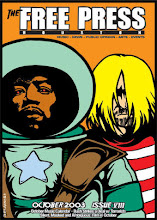Public Enemies

Right off the bat Public Enemies starts swinging for the outfield. The film by Michael Mann charts the last year or two of 1930s criminal John Dillinger as played menacingly by Johnny Depp. The look of the film, shot in HD, leans to a video look rather than a film look. Several recognizable actors are unrecognizable in brief but impressive parts. A theme emerges after viewing that relates to the meaning of words.
Alternating between robberies by Dillinger and his gang we follow the exploits of Melvin Purvis (Christain Bale). First Dillinger busts some buddies out of prison, then Purvis guns down Pretty Boy Floyd, then Dillinger robs a bank, then the Senate rebukes a young head of the Bureau of Investigation, J. Edgar Hoover, during a funding hearing. Purivs is appointed head of a special Chicago based team of agents who hunt down the new #1 criminal. The plot cleverly jolts back and forth between the official investigation (the moniker FBI came later) and gangster intrigue. For instance, Dillinger's activity begets new laws and increased surveillance which causes the mob to turn a cold shoulder when he attempts to hideout in Chicago.
Multiple machine gun shootouts heighten the action, additionally two cleverly executed jail breaks by Dillinger (not including the opening prison break) display his brazen ability to elude punishment. From what is known about the historical figure of Dillinger the film adheres to certain truths but doesn't make the reference obvious. In one scene we see Dillinger after being initially arrested getting his picture taken for the newspapers. Dillinger has his arm around the shoulder of a prosecutor and his thumb and forefinger are making a gun sign. In real life this photo op with its message to Dillinger's gang happened. When the moment comes in the film it's briefly seen and from the side, maybe with someone standing in the way. There's a matter of factness to Mann's version of history. It's like he striving for the upmost accuracy concerning settings and incidents but then he utilizes some new millennium digital camera voodoo.
What transpires during Public Enemies is beautifully realized and thoughtfully composed but the look sure ain't Technicolor. You see the texture of the clothing down to the ripple and the details on the car window frame or actor's faces reveal pits and pores. I have never seen such dark shades of the color blue (the hats and coats especially) in a movie. When Mann and DP Dante Spinotti blow out windows and light sources you see that solarization effect like you would see with a camcorder. In one sense there's an obvious design to the handheld widescreen lensing, yet every several minutes Mann throws in a shot where the face of the actor is too orange. It's like you want to go over and adjust the television only the image is 30-feet wide.
This neo-classicism Mann offers only makes the film more powerful. Someone watching this film 100 years from now wouldn't even know when digital photography replaced analog cinematography and would think that the film was shot with equipment peculiar to its era. Look at James Cagney films from the early 30s. Are the drive-bys and tommy gun play in those scenes realistic to the time or movie invention?
Public Enemies really revolves around the story of Dillinger and his girlfriend Billie Frechette (a vulnerable Marion Cotillard) who went to jail for a few years on the charge of harboring a criminal. Their relationship binds most of the movie together.
Frechette's incarcerated during the time Dillinger's gunned down outside of the Biograph theater. In Public Enemies' final scene a federal agent, played with humility by Stephen Lang, visits her in prison. This moment and what follows wraps up the film so succinctly you feel that Mann found the perfect ending to the story.









0 Comments:
Post a Comment
<< Home